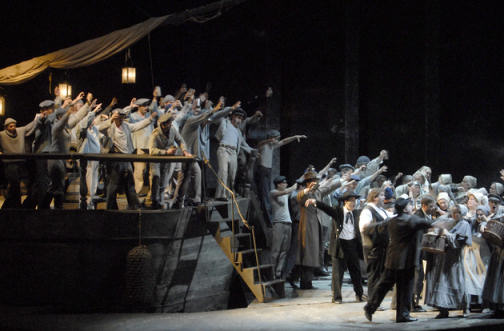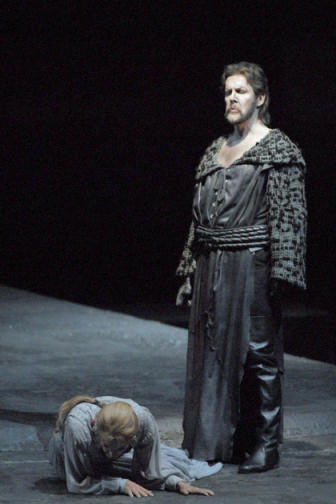Other Links
Editorial Board
-
Editor - Bill Kenny
-
Deputy Editor - Bob Briggs
Founder - Len Mullenger
Google Site Search
SEEN AND HEARD
INTERNATIONAL OPERA REVIEW
Wagner, Der fliegende Holländer:
Soloists, Chor der Sächsischen Staatsoper Dresden, Sinfoniechor Dresden,
Sächsische Staatskapelle Dresden, Christof Prick (conductor). Semperoper,
Dresden, 12.4.2009 (MB)
Daland – Michael Eder
Senta – Eva Johansson
Erik – Timothy Simpson
Mary – Sofi Lorentzen
Steersman – Timothy Oliver
The Dutchman – Alan Titus
Wolfgang Wagner (director, designs)
Johannes Taubenschuß (assistance with designs)
Reinhard Heinrich (costumes)
Fabio Antoci (lighting)
Eckart Kröplin (dramaturge)
Chor der Sächsischen Staatsoper Dresden
Wolfgang Wagner’s venerable production did not prove to be up to that particular
task. It must have seemed old-fashioned in 1988, when it was first given, not
least in the light of work by directors such as Harry Kupfer; now it seemed in
definite need of replacement. Some of its more old-fashioned aspects were not
unwelcome, especially when one considers what can go awry when baby, bathwater,
and all are modishly cast into the
Sinfoniechor Dresden< Matthias Brauer (chorus master)
Sächsische Staatskapelle Dresden, Christof Prick (conductor)

Sadly, whilst Christof Prick’s conducting could not rob the orchestra of its
sound, his direction had little else to recommend it, remaining Kapellmeister-ish
in the extreme. Almost unremittingly foursquare – one could hear the beats all
too clearly – Prick was either unable or unwilling to admit of any transitions,
let alone tempo variations. The Dutchman was reduced to a succession of
numbers: not, it seemed, as it had under
Marc Albrecht at Covent Garden, owing to a questionable interpretative
decision, but simply by default. And how it dragged! I thought the second act
was never going to end. In a superior performance, it would not have done, but
on account of a very different reason. For another unfortunate aspect of this
production was the decision to perform the three-act version of the work. I had
forgotten quite how regrettable this sounds once one has become accustomed to
the single-act version. Whilst I am well aware that, largely for practical
reasons, Wagner gave the Dresden premiere in three acts, this was not how he had
conceived it and, more importantly, it helps neither the narrative nor the
musical flow, assuming there to be one in the first place. Moreover, Wagner’s
1852 and 1860 revisions, whilst interesting musically, need a strong production
to make them sound anything more than tacked on dramatically. This is, I think,
a very different case from the Paris Tannhäuser.

Alan Titus was the best of the soloists as the Dutchman. ‘Die Frist ist um,’
began rather uncertainly, particularly in term of intonation, but once Titus had
settled down, he exhibited a commendably rich tone, which complemented the
orchestra. Moreover, one could hear every word he sang. He was certainly
preferable to
Bryn Terfel at Covent Garden, who had far too
often whispered or shouted – not that one would have known from many newspaper
reports. Eva Johansson had her moments as Senta but her intonation could be
alarmingly awry, a failing exacerbated by her habit of scooping up towards
notes. She had the same permanent look of derangement that I noted on her
DVD performance of the Walküre Brünnhilde from Aix. Senta might well
be mad – much depends upon guidance from the production – but she needs
something a little more individualised and a lot more in tune than this. Timothy
Simpson substituted for an ailing Martin Homrich as Erik. Simpson started rather
well, though he was not helped by Prick’s lifeless – which is not the same as
slow – tempi. However, in the third act, Simpson began to sound tired, leading
to an unfortunate near-collapse at the end of his part. Perhaps it was a matter
of nerves. Sofi Lorentzen and Michael Eder made decent jobs of their roles as
Daland and Mary, whilst Timothy Oliver was worthy of note as an accurate,
attractively-voiced Steersman. The choral singing, as opposed to its movement,
was generally of a high standard. Matthias Brauer clearly runs a tight ship in
this respect. However, the glowing sound of the orchestra notwithstanding, there
was too much that at best qualified as routine in this performance.
Mark
Berry
Pictures - Matthias Creutziger
Back
to Top
Cumulative Index Page
